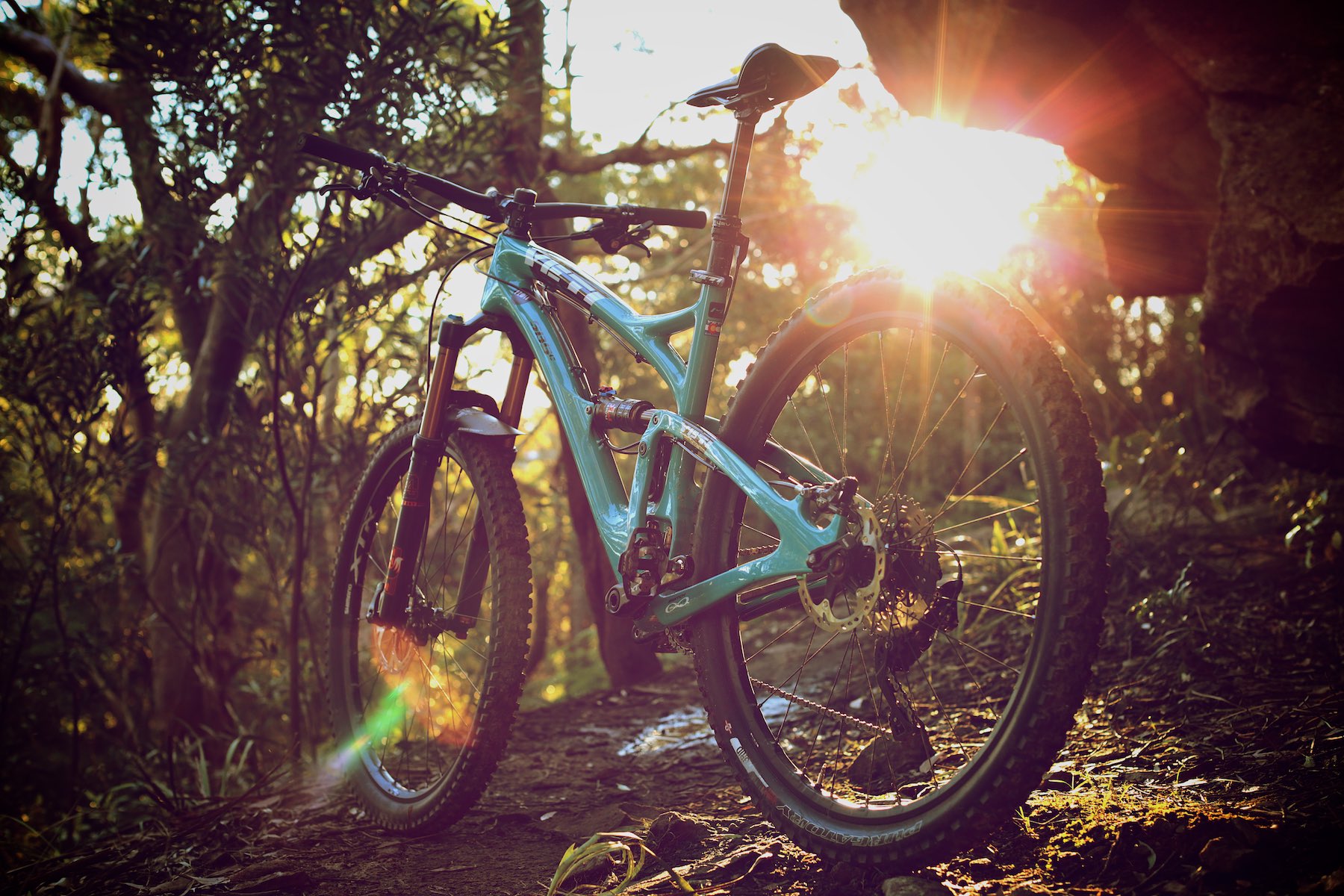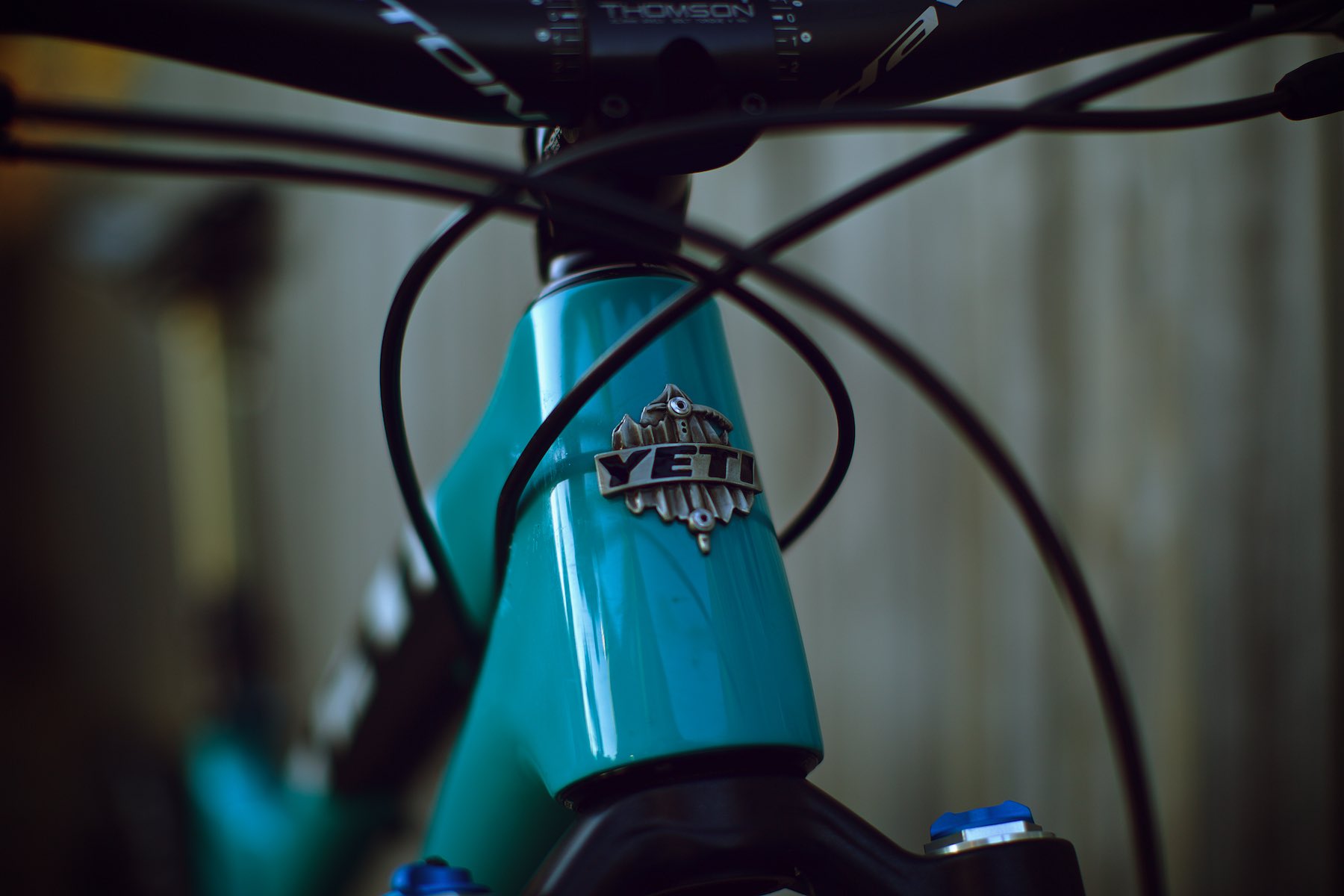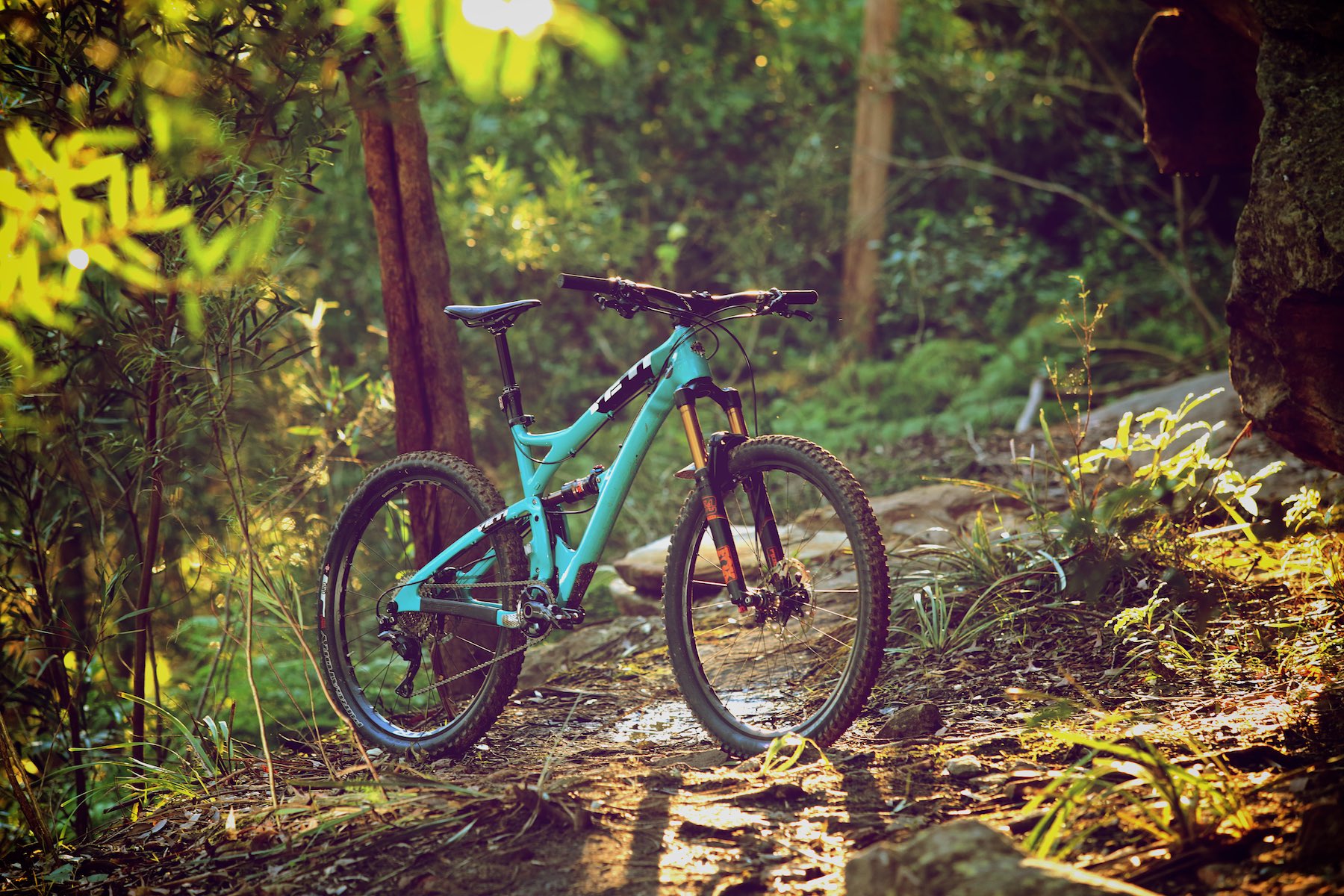“Ooooh, a Yeti,” said pretty much every mountain biker, ever. These beautiful mountain bikes from Colorado are at the cutting edge of frame design, steeped in racing heritage, and look hotter’n Georgia asphalt.
Their latest suspension design – the Switch Infinity – is as unique as they come, developed in collaboration with FOX Racing it turns some heads and perplexes others. We were lucky enough to spend a good amount of time on the Yeti SB5c and during that time (though knowing we had to return it) we tried our best not to, but we fell deeply, deeply in love.

[divider]Who is it for?[/divider]
The SB5c sits proudly in a category that caters for the majority of mountain bikers out there, trail riding. With 127mm of rear suspension travel, it’s not pretending to be a cross country race bike, or a hard hitting enduro machine, but more aimed to please the classic mountain bike rider looking to just have a good time out on the trails on a capable yet efficient bike.
The frame is wildly lightweight at 2.3kg, so you’ll have the ability to build it into a sub-12kg bike if you throw the money wand at it hard enough, opening it up to more possibilities than just a trail bike. You could probably dabble in marathon or endurance racing with a tricked out SB5c if you spent all your dough on only one bike and not a quiver of them.

It’s a flashy piece of kit, with the frame trading for around $4490, a Yeti owner is sure to know what they’re in for if that amount of cash is being exchanged. A Yeti is available from the Australian distributor as a bare frame, or one of the locally hand picked build kits ranging from $7930 up to $11485.
[divider]The frame[/divider]
The fluidly shaped SB5c comes in two colours – matte black and this lustrous glossy turquoise one, which is synonymous with Yeti. It is an all-carbon affair with a very unique suspension design at the heart of it all. Let’s get right into it and try to explain Switch Infinity.

Switch Infinity:
After a few good years of so many mountain bikers loving Yeti’s funky rotating eccentric Switch Pivot design (found on bikes like the SB95, SB75 and SB66) things got a little hot in relation to design patents between Yeti and other big brands, so the updated Switch Infinity was born. A product of the tight relationships between FOX and Yeti, it is a very fine concept.
It’s all about giving the rear suspension terrain-gobbling properties whilst maintaining pedal efficiency. Sound familiar? Well, it’s the holy grail of the mountain bike suspension world. Whether its with speed sensitive damping, fancy sensors and electronics, wheel paths, linkages, or persuasion through loads of marketing, the world of mountain biking is hungry for the best suspension system. Some get closer to the mark than others, whilst some flounder. In our opinion the Yeti’s Switch Infinity comes very close to perfection.

How does it work?
What looks like two Kashima coated FOX shock bodies inside the centre of the frame are actually sliders that carry the main suspension pivot up and down in a vertical plane as the rear suspension does its thing.
Watch Switch Infinity in action in this little video, accompanied by a very dramatic soundtrack for maximum feel:
Why?
It might look complicated at first glance, but in truth it’s pretty simple in operation. There are less pivoting points than your typical suspension bike, and with grease ports on the Switch Infinity sliders, maintenance is a real snack to do at home (or at least in the kitchen). And without a floating pivot design – for example a DW-Link, Maestro or VPP – the Yeti is able to do away with a link and have a one-piece rear end, which no doubt contributes to boosting rear end lateral stiffness and retaining low frame weight.
Yeti have been producing bikes with vertical rear travel paths for many years now.
The Switch Infinity concept is an evolution of previous Yeti suspension concepts, specifically the ‘rail’ design that was first seen on their original 303 downhill bike. It was revolutionary and a very unique experience to ride, the early versions would eat anything in its path but were not exactly agile to ride. Instead of pivoting around a couple points, the rear end would actually slide up and down on two rail tracks, and while the design has since been simplified their current downhill bike still uses a rail concept, and thus the SB6 and SB5 are products of this Yeti technology.
Execution:
This Yeti was with us for three months, and it sure did cop some bad weather. Upon inspection of the frame’s moving parts, we noticed a few of the sealed cartridge bearings had been affected by the conditions and had become rough, which we didn’t expect in this short timeframe.
The sealed cartridge bearings that sit on either side of the Switch Infinity sliders don’t have a large range of rotation in their role of the suspension action, which is what makes them prone to getting sticky. Bearings are smoothest and resist noise best when they’re moving, lubricating themselves, so we’d suggest whipping the rear end off the bike and giving all the bearings a spin every now and then to get the balls rolling and coated in grease, it’ll help avoid them going stiff like ours did from lots of wet weather riding. This is something we’d advise with just about all suspension bikes (especially those designs where the bearings only have a few degrees of rotation). After a few rotations, they were back to spinning freely, problem solved.

The Switch sliders each have a grease nipple, so pumping in some fresh grease and the pushing the old stuff out is a quick and easy job with a grease gun.
That said, the bike never made a noise from the suspension parts, we had no loose hardware and with readily available rebuild kits, the maintenance of this system is really quite simple if you are up for it.
[divider]Geometry[/divider]
The SB5c isn’t a long and slack number, it strikes a good balance between all-round agility and stability with some sharp but sensible angles.
We used the SB5c with a 140mm fork, whilst most of these bikes are specced with a 150mm fork as standard. Fitted with a 150mm travel fork, the head angle is said to be 66.5 degrees which puts it in the middle ground between a cross country and enduro race bike. With a 140mm fork however, it’ll sharpen the angle to 67 degrees and quicken the steering a touch. Did we regret going 140mm instead on 150mm? Only in some extreme descending situations, but 99% of the time we thought the angles with the 140mm fork were awesome.
Interestingly, Yeti’s EWS racers Jared Graves and Richie Rude have both raced the SB5 with up to a 160mm fork on it, so it’s obviously a bike that’s comfortable with some serious firepower up front.

The other important numbers are; 442mm chainstays, 72.3 degree seat tube angle, and a 599mm top tube length in a medium.
The bottle cage mounting is a bit tricky, with the two bolts right underneath the downtube making for a big reach to get your water bottle which has been covered in roost from your front tyre. It’s really a hydration backpack type of bike, the price you pay for having the rear shock and moving parts in the middle of the frame, unfortunately.

[divider]Spec[/divider]
Our SB5c is a real mutt, we built it from a bare frame using a Shimano XT 11-speed kit, and new 2016 FOX suspension. From the Australian Yeti distributer – Rowney Sports – you can pick and choose from a variety of build kits using SRAM or Shimano, and RockShox or FOX.
You’re also be able to choose fork travel, between 140 and 150mm. It’s a good option to have, 10mm more travel might not sound like much, but the slightly higher or lower front end will help you tune the setup to your trails.

We did wish we had ridden this bike with a standard 2015 FOX rear shock, as the new DPS shock with the EVOL extra volume air can is a pretty special piece of kit. We can only imagine that part of our praise for this bike’s performance can be attributed to the new rear shock’s abilities. Luckily, if you’re running the standard non DPS shock, you can look at upgrading it with an aftermarket EVOL air sleeve to bring it up to speed. We’d highly recommend it.
[divider]Ride Impressions[/divider]
On our local Sydney trails the SB5c felt as perfectly suited to the rocky and challenging terrain as any bike we’ve ever ridden. Every ounce of effort and input we had translated into fast handling through corners and efficient speed across rough terrain, riding the Yeti feels very rewarding.
Singletrack manners:
Most often are we finding ourselves riding bikes that shine on only some sections of the trail, and have only acceptable performance in others. The Yeti however was just as at home blasting steep descents, laying smooth power down through the singletrack or popping up and over the rocky ledges. It just didn’t feel compromised in any area.
The way it would rapidly change direction and somewhat intuitively know where you want to go had us twisting our way through turns with less effort than we’d become used to on such familiar trails.

The Easton handlebars were on the narrow side – at 740mm – so our hands were pushed right out towards the end of the grips when riding. While they did feel a little small when it got rough, the positive traits of a narrower bar really matched the Yeti’s vibe. Quick, light direction changes and the increased clearance in tight trails was very obvious, plus tipping the bike down side-to-side onto the side knobs of the tyres would create a super aggressive position to really bite into the dirt and rip around a turn with pace.
The rear shock has a wide range of compression tuning, adjustable on the fly via the little blue lever. We spent 90% of our time in the Trail mode, and only let it open on the roughest of descents, and firmed it up for a tarmac climb. Even in the Trail mode, the suspension flowed over the terrain like melting butter in a Teflon pan. As we mentioned above, maybe the new EVOL air can on the shock had a hand in this, but the way it responds to the bumps is just eerily smooth.
Descending:
Yetis and descending go together like Vita Wheats and cheese. For a bike with only five-inches of rear wheel travel, this thing is a hammer. In fact, it was onboard the SB5 that we set our fastest ever times down some very rough descents, even though we regularly ride these trails on 150-160mm bikes.
The sharper head angle as a result of the 140mm fork meant the SB5 would sometimes find its limits when rolling down the backsides of big rocks, and into more rough terrain. With the beefy 34mm fork legs, though, we were able to muscle our way out of situations that may have been over the Yeti’s head. But we were generally very, very happy with what it was capable of handling when pointed down.
As we’ve noted above, we’ve seen Jared Graves racing enduro on this frame with a 160mm travel fork – we wonder how that would go?

The rear suspension handles hard square-edge impacts much better than its SB75 or SB66 predecessor. It takes a lot of pounding for the SB5c to lose momentum, you’ll be able to keep the power on and pedal hard over the rockiest trails without slowing down.
It’s quick to get up to speed, and the portion of vertical wheel travel really lets the rear wheel move up and away from the path of impacts.

Climbing:
The SB5c hides its travel really well, the way you can mash away on the pedals without the bike bouncing around beneath you is testament to the well-executed rear axle path design. Tension on the chain helps to keep the rear suspension from squatting, and that’s what stops the rear shock absorbing your pedalling efforts.

There’s also plenty of room to get up and out of the saddle and crank down on the pedals without bashing your knees on the bars.
On trails where you have to lift the bike up and over obstacles, we found the SB5 to be quite amazing. Whether it was the light rear end, roomy top tube or supportive rear suspension, we think it all has a lot to do with why we found ourselves hopping up bigger steps with much less effort than we had expected. Is this cheating?
Final thoughts:
This is a really, really nice bike to ride. We found it very poppy and agile, super-efficient and so light to ride.
By striking a perfect balance between what you want out of a bike going up, and going down, this Yeti succeeds in confirming its place as one of the finest trail bikes you’ll ever find.
The frame geometry and supple suspension won us over, if we were to manufacture our own bike from scratch, we’d probably try and base the design around the figures that shape this bike. Or we could just save up and buy one…

You could dress it with some meatier parts and you’ll have a light enduro race bike, or keep it trim and it would serve you well as a superbly capable and comfortable all-day trail bike. And yes, it’s expensive but if you know what you want out of a high end mountain bike, the SB5c will love you back like you’d always dreamt.